|
|
|
Sort Order |
|
|
|
Items / Page
|
|
|
|
|
|
|
| Srl | Item |
| 1 |
ID:
180358
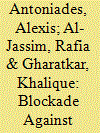

|
|
|
|
|
| Summary/Abstract |
On 5 June 2017, the United Arab Emirates, Bahrain, Saudi Arabia, and Egypt cut diplomatic ties with the State of Qatar and initiated a blockade against the country. In this study, we provide the first in-depth examination of the impact the blockade had on Qatar’s economy and review the policy responses that followed. In particular, we consider how the policies that have since emerged either complemented or deviated from past policies and practices and evaluate whether they have in fact brought long-term benefits to the country –– benefits that may have not been realized had the blockade not taken place. Our review finds that the blockade did not cause a shift in policy direction, but it did change the urgency and process by which policies were put together and pushed forward, as well as their effectiveness. Furthermore, we find that the timing of the blockade worked in Qatar’s favor in surprising ways. To the best of our knowledge, this is the first study to provide both a meticulous documentation of the policy responses that followed the blockade and an in-depth analysis of its impact.
|
|
|
|
|
|
|
|
|
|
|
|
|
|
|
|
| 2 |
ID:
180355
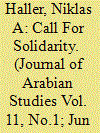

|
|
|
|
|
| Summary/Abstract |
While the contemporary political and economic ties between the Gulf region and the Levant are widely acknowledged, the deeper historical roots of this modern relationship are rarely recognized in light of persistent narratives of the Gulf’s relative isolation before the discovery of its hydrocarbon wealth. Building on a study of the British archival record, this article contributes to a challenge of such narratives by examining one of the earliest instances in which mutual ties became manifest: the political and financial support for the Arabs of Palestine by the population of the Trucial States (the contemporary United Arab Emirates) in the interwar years. As is shown, the development of pro-Palestinian sentiment was enabled not only by an earlier expansion of education in the Trucial States, but also by rapidly developing communication links between the Gulf and the wider Arab world. As a result of these developments, the population of the Trucial States was subject to –– and proved receptive to –– calls for Arab and Muslim solidarity emanating from Palestine in the late 1930s.
|
|
|
|
|
|
|
|
|
|
|
|
|
|
|
|
| 3 |
ID:
180357
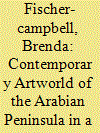

|
|
|
|
|
| Summary/Abstract |
This article analyzes the production and presentation of artworks of three countries of the Gulf Region –– Qatar, the UAE and Saudi Arabia –– to evaluate its place and potential in the globalized artworld. The Gulf region is a small but significant part of the global artworld with high potential for further development. Art globalization in the Gulf began to develop only in the 2000s –– from about 2006 in the UAE, followed by a second wave in Qatar five years later. A third wave is rising with the increasingly international exposure of Saudi Art. The article examines which factors are essential for participation in a globalized art world and whether the region enjoys international recognition on the global stage. A composite artworld ecosystem model comprising institutions, artists and their artworks, commercial entities and government was conceived on a philosophical and sociological basis within a historical and geopolitical framework. The roles of the museum, biennials, art galleries and art fairs, are converging in many respects. All the nodes of the artworld ecosystem are required for globalization, with participation in the biennial model being the most important factor, being more flexible than the museal institutions in funding and programming. To reach a wider audience, the art fair model could be more relevant than the more esoteric biennial format. The Gulf region’s patrons possess strong motivations for supporting the arts of the region internationally. In addition, the desire to enter the global cultural world through the promotion of art museums as a tourist destination is a strong motivator for governments.
|
|
|
|
|
|
|
|
|
|
|
|
|
|
|
|
| 4 |
ID:
180360
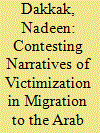

|
|
|
|
|
| Summary/Abstract |
The experiences of migrant workers in the Arab Gulf States tend to be understood through narratives of victimization. This article aims to problematize such narratives through an analysis of three short stories set in the Gulf by Filipina-American writer Mia Alvar from her debut collection In the Country (2015). Mapping out ways in which these stories depart from narratives that revolve around themes of exploitation and exclusion, the article demonstrates that fiction can critically engage with the tension between the need to represent and make visible the reality of migrant experiences in the Gulf, and the need to question the essentialism and inflexibility through which they tend to be framed. Using the insights of recent anthropological and ethnographic research on the Gulf’s non-citizen population, I argue that Alvar’s stories both expose the structural inequality that facilitates victimization and pave the way for a more nuanced understanding of migrant experiences in the Gulf.
|
|
|
|
|
|
|
|
|
|
|
|
|
|
|
|
| 5 |
ID:
180356


|
|
|
|
|
| Summary/Abstract |
This study uses the concept of enregisterment to trace the development and construction of the Badawī dialect in Harūb, Jāzān, Saudi Arabia. The analysis shows that the salient linguistic feature ch used in Harūb has become enregistered with Badu identity in terms of ideologies of linguistic differentiation. This paper is an ethnographic study that explores the meaning of Badu which has been localized to the Jāzān region. The historical and social processes of isolation, modernization and marginalization have given rise to discursive practices of naming and drawing boundaries around ways of speaking in Jāzān. Finally, this paper highlights the ideological nature of language and calls for more studies in Arabic linguistics to consider the “total linguistic fact”.
|
|
|
|
|
|
|
|
|
|
|
|
|
|
|
|
| 6 |
ID:
180354
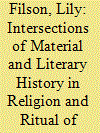

|
|
|
|
|
| Summary/Abstract |
The reconciliation of Ibn al-Kalbī’s ninth-century CE text of on pre-Islamic Arabia with modern scholarship offers certain insights to religious practices in the Arabian Peninsula from prehistory through the seventh cenury CE This study integrates his early Book of Idols into existing archaeological and anthropological studies about diverse aspects of pre-Islamic religion and ritual: diverse forms of litholatry; pilgrimage rituals; and the social economy of sacrifice and rain rogation rituals. Al-Kalbī’s text is recognized rightly for its essential character as a product from a distinct cultural milieu, early Islamic Kūfa, distant by time, geography, and culture from the pre-Islamic culture of Arabian antiquity of the peninsula and particularly the ancient kingdoms of Yemen in the southwest. Nevertheless, this article analyzes this contested source for several of its alignments with recent archaeological and anthropological findings.
|
|
|
|
|
|
|
|
|
|
|
|
|
|
|
|
| 7 |
ID:
180361


|
|
|
|
|
| Summary/Abstract |
Muscat, the capital of the Sultanate of Oman, has been developed since the 1970s with typical characteristics such as high urbanization rate, low-density urban sprawl, and private car based mobility. Land-use patterns favour the separation of functions, creating long distances for daily trips and a high traffic volume. State investments went into developing and improving the road network while the public transport has been neglected for a long time. In light of depleting resources and the recent decline of oil revenues, however, a first rethinking of transport policies and land use planning has set in. Diversifying the economy has become a major aim and efforts are made to encourage the private sector and to attract foreign direct investment. With regard to urban development, these policies are reflected in increasing changes in land use patterns. The paper analyses ongoing land use changes in al-Ghubra North, a multifunctional neighbourhood in Muscat, and discusses how far these forms of land use change contribute to a more sustainable urban structure and more sustainable mobility patterns.
|
|
|
|
|
|
|
|
|
|
|
|
|
|
|
|
| 8 |
ID:
180359


|
|
|
|
|
| Summary/Abstract |
This paper assesses the strategies of the United Arab Emirates (UAE) to instill leadership values and to encourage youth to take leadership roles as a solution for the future sustainable economic growth. In recent years, the UAE government has stepped up initiatives to encourage the Emirati youth to become leaders, as seen in the establishment of, among others, the UAE Youth Global Initiative, the Ministry of Youth Affairs, the Emirates Youth Council, the National Youth Agenda, and the UAE Youth Programme launched under the UAE Government Leaders Programme (UAEGLP). Such steps are accompanied by country’s support for high quality education on a tertiary level available to every citizen willing to pursue their education. This article examines in what ways such attempts at social engineering may provide solutions to the country’s future needs and serve as a model abroad. The research was conducted using data collected from governmental agencies, and interviews with representatives of youth government initiatives.
|
|
|
|
|
|
|
|
|
|
|
|
|
|
|
|
|
|
|
|
|